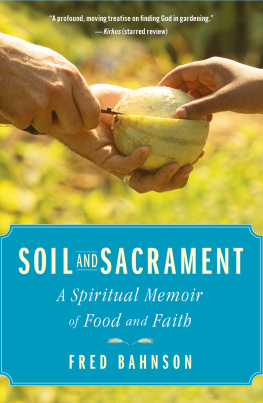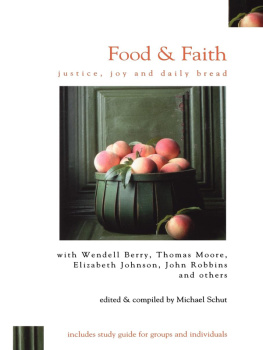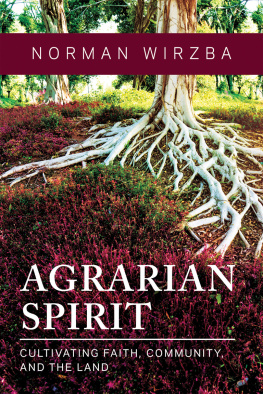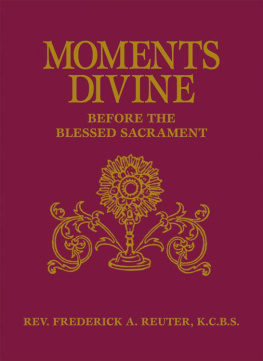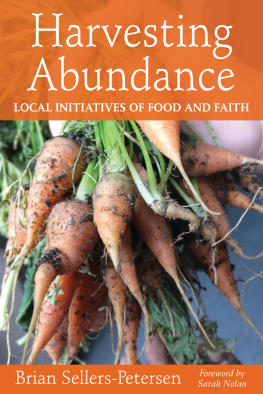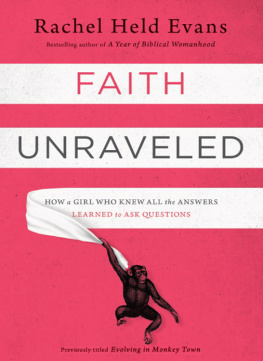Praise for Soil and Sacrament
This is a spiritual memoir with real dirt under its fingernails, as deep and gritty and rich as well-tended soilor Holy Scripture. Fred Bahnsons vision matters, and the work he writes so beautifully and unsentimentally about has the power to change communities. An important and moving book.
Sara Miles, author of Take This Bread and City of God
This is a very moving as well as a wonderfully intelligent meditation on what is involved in care for our earth. Fred Bahnson succeeds in showing how our practices of cultivating the environment and producing our food can become an integral part of a gospel for all creation. In a culture obsessed with both growth and control, his spiritual insight is a gentle but clear challenge.
Rowan Williams, former Archbishop of Canterbury
Theres been an explosion of activity at the intersection of food and faith in the last ten years. Fred Bahnsons book is superbits incredibly readable, its exciting, and most of all, its inspirational.
Nigel Savage, founder and president of Hazon
About once in a generation, an American writer delivers a memoir that unites the spiritual longing of every soul with the particular challenges of their day. I think of Mertons Seven Storey Mountain or Dillards Pilgrim at Tinker Creek. These books resonate because they are a distillation of one persons hope, which echoes in the heart of every reader. I realized this book may be one of them when I not only couldnt put it down but also couldnt stop thinking of all the people I wanted to give it to when I was finished.
Jonathan Wilson-Hartgrove, author of Strangers at My Door
Fred Bahnsons Soil and Sacrament reminds us that among the most necessary recoveries that may serve to heal a splintered personhood and a splintered community is the essentially agnostic the not Gnosticreturn to a love for and the care of the stuff of creation. As we are wooed away from false and debilitating dichotomiesof body and spirit, of substance and essencewe find before us a people and a land laden with spirit. We know now that our hunger is not for transcendence, but for immanence.
Scott Cairns, author of The End of Suffering
Thank you for downloading this Simon & Schuster eBook.
Join our mailing list and get updates on new releases, deals, bonus content and other great books from Simon & Schuster.
C LICK H ERE T O S IGN U P
or visit us online to sign up at
eBookNews.SimonandSchuster.com
Contents
Advent, Mepkin Abbey, South Carolina
Eastertide, the Lords Acre, North Carolina
Pentecost, Tierra Nueva, Washington
Sukkot, Adamah Farm, Connecticut
For Elizabeth, Carsten, Elijah, David:
ALL MY LOVE
The glory of God is a human being fully alive.
Saint Irenaeus
Prologue
Cedar Grove, North CarolinaDecember 2008
Winter is my favorite growing season. Anyone can toss down a few seeds in June and get a crop, but it takes a disciplined hope to garden in the dark of December. And what rewards. After several frosts, plant starches become sugars. Carrots attain the sweet crunch of apples, and kale loses all hint of bitterness. Turnips become so sugary you can eat them raw.
Mid-morning on the first Sunday in Advent, I stood beside the red-roofed barn and looked out at Anathoth Community Garden. Down the hill the greenhouse was shedding its frost in the first light. Along the creek sat the childrens playhouse, and beyond that the site of our future orchard. But the sight that always drew my eye was the wide expanse of the field itself, a wave-and-trough succession of raised vegetable beds lying dark and still in the low winter light, pregnant with life waiting to be born. Soon I would need to drive a mile down the road to the little Methodist church where my wife and sons would be arriving for the morning service, but first I needed to come here, to this five-acre piece of land that had come to feel like an extension of my own body. Over the past three years of working here I had grown attached to this garden and its people. They had fed me in so many ways. Perhaps too many ways.
I walked downhill to the greenhouse, a Gothic arch structure where we grew most of our winter crops and started all our seed. Heated entirely by the sun and ventilated by wax pistons, it was off the grid. This was my favorite of winter places, my sanctuary; I could lose myself in here for hours. What a thrill I received each morning as I entered this congregation of plants, lit as if from within by the low winter sun. The world outside the greenhouse was nineteen degrees cold; dry and lifeless. Once I stepped across the wooden threshold, the temperature rose to a balmy forty, lush and humid and alive with the earthy aroma of plants seeking light.
The soil here was deeper than in the rest of the garden, the color and consistency of chocolate sponge cake. Even on the coldest of winter days, black organic matter in the soil absorbed the suns heat and slowly released it at night, keeping the plants alive. The beds, each four feet wide and thirty feet long, were double-dug. While the topsoil of a rototilled garden descends a mere eight inches, our greenhouse beds reached a depth of at least two feet, mimicking the fertile, loamy soils of the American prairie or the Russian steppe. With such deep beds, roots have better access to water and minerals deep in the ground. Plants can be spaced closer together, quadrupling yield. Thousands of years ago the Greeks realized that plants grew better in mountain landslides. The deep soil there was loose and friable, allowing the roots easy access to nutrients. A double-dug bed is like an underground landslide. Roots flourish in such deep tilth, creating a vast subterranean network that feeds aboveground life.
I spent much of my time at Anathoth preparing and working and thinking about the soil. There is an entire ecosystem in a handful of soil: bacteria, fungi, protozoa, nematodes, earthworms. Through their breeding and dying such creatures vivify the world. This pattern of relationships I find a captivating mystery; I love plants, but I am most attracted to the fervent and secret work that goes on beneath the surface.
Soil is not dirt. It is a living organism, or rather a collection of organisms, and it must be fed. Soil both craves life and wants to produce more life, even a hundredfold.
The true profundity of our soil was difficult to gauge. One day I slid my hand into one of the greenhouse beds. I gently pushed down and kept pushing until my arm vanished and my shoulder touched the soils surface. It had seemed then as if I could keep burrowing downward, until my entire body was swallowed by the warm, dark earth.
Soil is a portal to another world.
That Sunday morning I was alone in the garden.
Anathoth was a food garden for the communityour sixty members worked the land in common and shared its bountyyet more and more I had found myself going there at such times to escape people. I was by nature reclusive, yet my role as Anathoths director required me to act as a public figure, putting on a smile and chatting up the members, who worked a minimum of two hours a week in exchange for produce. The truth was that I had less and less energy for peopleeven my own family. Increasingly I felt accosted by so many people needing something from me, and no matter how deeply I wanted to give them what they needed, all I wanted to do was withdraw.
The Sunday morning service down the road at Cedar Grove United Methodist Church would begin soon, but I remembered that there were beds that needed cover cropping; I had a sudden desire to plant. Leaving the greenhouse I walked back up to the barn and reached for the blue hand-cranked seed spreader, opened a bag of rye, and poured in the seed. I mixed rhizobium inoculant into a bucket full of hairy vetch and crimson clover seed, added a few drops of water, and stirred them together with the rye. Vetch and clover are legumes, plants that form a beneficial relationship with rhizobium bacteria. Their roots would supply nitrogen not only to the rye but also to the crops that would follow in the rotation. Its a beautiful symbiosis: legume roots provide the bacteria with sugars and in exchange the bacteria fix nitrogen into tiny pink nodules that cling like barnacles to the legume roots. The bacteria and legumes serve one another. The rye stalk provides a structure for the legumes to climb, and ryes fibrous roots mine minerals from the subsoil, reaching ten feet down into the earth. Its a trinity of abundancerye, vetch, and clovereach freely giving up its body for the others nourishment, each dying so that the other may live.
Next page
